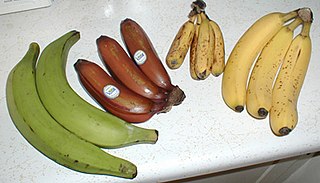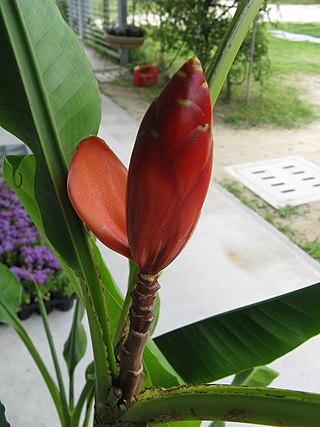
A banana is an elongated, edible fruit – botanically a berry – produced by several kinds of large herbaceous flowering plants in the genus Musa. In some countries, bananas used for cooking may be called "plantains", distinguishing them from dessert bananas. The fruit is variable in size, color, and firmness, but is usually elongated and curved, with soft flesh rich in starch covered with a rind, which may be green, yellow, red, purple, or brown when ripe. The fruits grow upward in clusters near the top of the plant. Almost all modern edible seedless (parthenocarp) bananas come from two wild species – Musa acuminata and Musa balbisiana. The scientific names of most cultivated bananas are Musa acuminata, Musa balbisiana, and Musa × paradisiaca for the hybrid Musa acuminata × M. balbisiana, depending on their genomic constitution. The old scientific name for this hybrid, Musa sapientum, is no longer used.

Musaceae is a family of flowering plants composed of three genera with about 91 known species, placed in the order Zingiberales. The family is native to the tropics of Africa and Asia. The plants have a large herbaceous growth habit with leaves with overlapping basal sheaths that form a pseudostem making some members appear to be woody trees. In most treatments, the family has three genera, Musella, Musa and Ensete. Cultivated bananas are commercially important members of the family, and many others are grown as ornamental plants.

Ensete is a genus of monocarpic flowering plants native to tropical regions of Africa and Asia. It is one of the three genera in the banana family, Musaceae, and includes the false banana or enset, an economically important food crop in Ethiopia.

Musa is one of two or three genera in the family Musaceae. The genus includes flowering plants producing edible bananas and plantains. Around 70 species of Musa are known, with a broad variety of uses.

Musa basjoo, known variously as Japanese banana, Japanese fibre banana or hardy banana, is a species of flowering plant belonging to the banana family Musaceae. It was previously thought to have originated in the Ryukyu islands of southern Japan, from where it was first described in cultivation, but is now known to have originated in subtropical southern China, where it is also widely cultivated, with wild populations found in Sichuan province.

Musa acuminata is a species of banana native to Southern Asia, its range comprising the Indian Subcontinent and Southeast Asia. Many of the modern edible dessert bananas are from this species, although some are hybrids with Musa balbisiana. First cultivated by humans around 10 kya, it is one of the early examples of domesticated plants.
Musa maclayi is a species of seeded banana native to Papua New Guinea and the Solomon Islands. It is placed in section Callimusa. It is regarded as one of the progenitors of the Fe'i banana cultivars.
Musa tuberculata is a tropical Asian species of plant in the banana family native to the Malesian region (Brunei). It is one of fourteen species of Musa endemic to the island of Borneo. The specific epithet "tuberculata" is from the Latin meaning "covered with minute tubercles". M. tuberculata is placed in section Callimusa, members of which have a diploid chromosome number of 2n = 20.
Musa siamensis is an Asian tropical species of plant in the banana family native to Indo-China (Thailand).
Musa × alinsanaya is a Malesian tropical plant in the banana family (Musaceae), native to the Philippines. Only formally named in 2004, it is considered to be a hybrid between Musa banksii and Musa textilis. The flower bud is shiny green with purple inside. It produces small fruit with a high proportion of seeds.
Musa salaccensis, commonly called Javanese wild banana, is a Malesian tropical species of plant in the banana family native to the islands of Sumatra and Java, in Indonesia. It is placed in section Callimusa, members of which have a diploid chromosome number of 2n = 20.

Fe'i bananas are cultivated plants in the genus Musa, used mainly for their fruit. Unlike most other cultivated bananas they are diploids of the AA-type. They are very distinct in appearance and origin from the majority of bananas and plantains currently grown. Found mainly in the islands of the Pacific, particularly French Polynesia, Fe'i bananas have skins which are brilliant orange to red in colour with yellow or orange flesh inside. They are usually eaten cooked and have been an important food for Pacific Islanders, moving with them as they migrated across the ocean. Most are high in beta-carotene.
Musa hirta is a tropical Asian species of plant in the banana family native to Sarawak on the island of Borneo, in Malaysia. It is one of fourteen species of Musa endemic to the island of Borneo. It is placed in section Callimusa, having a diploid chromosome number of 2n = 20.

Musa coccinea, commonly known as scarlet banana or red-flowering banana, is a species of flowering plant in the banana and plantain family Musaceae, native to tropical China and Vietnam. It is a bat-pollinated evergreen perennial, placed in section Callimusa, having a diploid chromosome number of 2n = 20.

Ernest Entwistle Cheesman, was an English botanist noted for his work on the family Musaceae. He was the son of Charles Cheesman and Grace Lizzie Davies. About August 1936 he married Ellen Elizabeth B. Weston (1892-1966).

Musa beccarii is a species of wild banana, found in Malaysia, in Sabah. It is placed in section Callimusa. The flower bud is narrow, bright scarlet with green-tipped bracts. The fruit is green and thin. The species is named after Italian naturalist Odoardo Beccari.
Musa fitzalanii is a species of wild banana, which was native to north-east Queensland, Australia, but is now believed to be extinct. The type specimen was collected in the 19th century, from the vicinity of 'Daintree's River most likely by Eugene Fitzalan, an Irish collector who apparently worked with Ferdinand von Mueller, the first describer of the species. Along with M. acuminata and M. jackeyi, it was one of the three species native to Australia. It was placed in section Callimusa.
Musa peekelii is a species of wild banana, native to eastern New Guinea and the Bismarck Archipelago. It is placed in section Callimusa, members of which have a diploid chromosome number of 2n = 20. It is a very tall plant, reaching over 10 m (33 ft), with a narrow green drooping bud. The ripe bananas are red with bright yellow flesh. It is one of the possible parents of the cultivated Fe'i bananas.
Musa arunachalensis is a species in the genus Musa. It was first described in 2013 by botanists from the University of Calicut in Kerala.

Mamiyil Sabu formerly Head of the Department of Botany, University of Calicut and currently working as CSIR-Emeritus Scientist at Malabar Botanical Garden and Institute for Plant Sciences, Kozhikode district, Kerala, India. He worked for over 37 years on the research of gingers, which include families such as Cannaceae, Marantaceae, Zingiberaceae, Heliconiaceae, Costaceae, Musaceae etc. A comprehensive work on these groups have been taken after a gap of 125 years, which resulted in the discovery of several new species and rediscovery of many species after 155 years.











